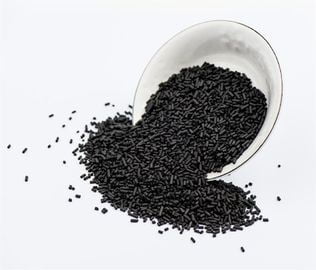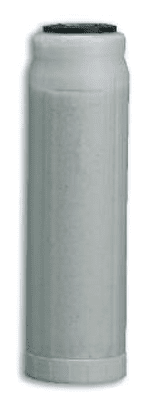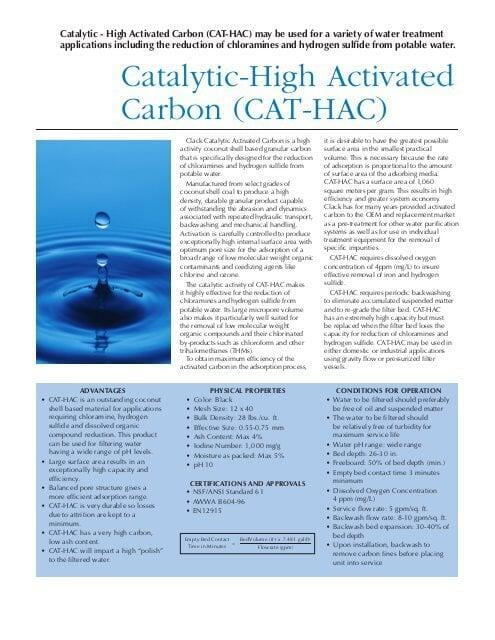Why We Use Catalytic Carbon Instead Of Regular Carbon Products
Chloramine has replaced chlorine as the disinfectant of choice for most water treatment systems across the country. Chloramine is the combination of chlorine and ammonia. Unlike chlorine, chloramine is very difficult to remove from water. It goes right through reverse-osmosis systems and distillers and gets concentrated in the product water. Besides chloramine, there are dozens if not hundreds of other difficult-to-remove chemicals routinely found in drinking water supplies.
LivingWaters™ is committed to our customer's safety, and while this media is 10X as expensive as regular carbons, we use a large volume of it in every system we produce. We want to insure that your drinking water is as free of dangerous chemicals as possible. This is one reason our systems are more expensive than cheaper systems available at big-box stores or the internet. You get what you pay for. Our customers come to us because they want the best system for cleaning their water that they can get. This is one of many reasons our systems are the best.
Catalytic carbon is a specially processed filter medium designed to greatly enhance carbon's natural ability to promote chemical changes in contaminants. Standard filter carbon reduces contaminants in two ways. It “adsorbs” chemicals by trapping and holding them, and to a smaller degree, it “chemisorbs” contaminants by changing them to something harmless. Chlorine, for example, can be “catalyzed” to harmless chloride.
Catalytic carbon retains conventional carbon's ability to adsorb contaminants but it also possesses greatly enhanced capacity to catalyze or promote beneficial chemical reactions. It is by catalytic action that chloramine is reduced.
We use a large bed of catalytic carbon in every LivingWaters™ Alkalizer™ because it is THE ONLY PRACTICAL WAY to remove chloramine and other difficult-to-remove chemicals from drinking water supplies.
Most manufacturers won't use the media because it is so expensive and consumers, for the most part, are still unaware of the health problems associated with the consumption of chloramine, pharmaceutical residues, and things like fire-fighting foam in drinking water. They would rather advertise that their systems "reduce" chloramine. In fact, this reduction, to the extent it occurs is so marginal as to be insignificant. If the system does not contain a large bed of catalytic carbon, it cannot do the job you expect. Don't fall for it.
The Problem of Chloramine
Most of us are familiar with chlorine. For most of the 20th century, chlorine was the disinfectant of choice for public water supplies. Now it is being rapidly replaced by a substance called chloramine, a mix of chlorine and ammonia.
The decline in the use of chlorine began with the relatively recent discovery of a group unsavory and often carcinogenic spin-off chemicals called trihalomethanes (THMs) that are formed when chlorine combines with organic matter in water. To meet EPA standards for THMs, which once created are hard to remove, municipal suppliers are turning increasingly to disinfection with chloramines, which produce much lower levels of trihalomethanes.
As often happens in our imperfect world, however, the solution to the THM problem brought its own set of problems. For example, chloramine can be deadly to fish in aquariums and ponds and to patients on dialysis machines. For regular home use, water with chloramine presents aesthetic issues of bad taste, odor and skin irritation. And let's be frank: its long-term effect on health is largely unknown. Chlorine, after all, was added to water for decades before THMs were discovered. What we are discovering about chloramine and health is seriously bad news.
Removing Chloramine
For a variety of reasons, increasing numbers of people want chloramine out of the water they drink and bathe in. The most important one is that we now know that chloramine is not degraded in the stomach, but passes into the gastrointestinal tract where it kills the "friendly" bacteria in our gut that are so important to health. These bacteria, yeasts, and other microorganisms are the most important part of what is called your microbiome. Disruption of the balance of the many species of these microorganisms is now seen to be the cause of the vast majority of chronic debilitating diseases. Because chloramine and other chemicals found in drinking water like fluoride disrupt this balance, chloramination of drinking water is likely to become one of the great health scandals of our time - even outpacing the now discredited practice of fluoridation to win this dubious title.
One of the big myths about chloramine is that it can't be removed. Actually, it is removed with carbon, the same filtering agent that very effectively removes chlorine. The difference is that chloramine is much harder to remove. Therefore, it takes more carbon and water must be given more residence time in the carbon. In other words, you need a considerably larger carbon bed and a significantly slower flow rate to remove chloramine with standard carbon.
Chloramine is not removed by distillers or reverse-osmosis systems. Its molecular weight allows it to pass right through and become concentrated in the product water. When it comes to chloramine, these kinds of systems make the product water much worse for you - not better. Since most bottled water that claims to be "purified" is chloraminated city water treated by reverse osmosis, stay away from it. If you need to buy bottled water, buy a brand of spring water like "Fiji" water or something similar instead.
The best idea is to invest in a LivingWaters™ Alkalizer™ and your water will cost about 10¢ a liter instead of over $1.00 a liter. At that rate, the system will pay for itself in six months or less for a family of two.
This article explains how catalytic activated carbon is so superior to other forms of carbon for chloramine and other difficult-to-remove chemicals from water.

- Catalytic carbon is proven in theory, and in practice, to be the most effective media available to remove chloramine and other difficult-to-remove chemicals from water. This includes things like perchlorate, fire-pharmaceutical residues like those that happen when birth control pills, pain-killers, heart medications and others get flushed down toilets.
- Catalytic carbon is the most efficient media at removing pesticides and herbicides like glyphosate from drinking water supplies
- Fire-fighting foam has emerged as a significant source of pollution in over 126 drinking water systems close to US military bases. This foam contains polyfluoroalkyl or perfluoroalkyl chemicals (PFASs) from the firefighting foam, which include perfluorooctanoic acid (PFOA), one of the highly toxic chemicals used in the production of Teflon, and a similar chemical, perfluorooctanesulfonic acid (PFOS).
Good News If You Already Own Another Drinking Water System

If you have an RO System, Distiller, Ionizer, or other filter that uses a standard 10" carbon cartridge as a pre-filter, you can use a LivingWaters™ Chemical Reduction Filter instead of the carbon filter that comes with the system. This way you can use your existing system to effectively remove the chloramine and a lot of other chemicals that can make it through your RO system without having to buy a whole new system.
If you own one of the new "twist-on" designs, you are probably out of luck. Most manufacturers don't make a filter with catalytic carbon to use with their new fangled RO systems.
Reduction Mechanism - for you science minded folks
Monochloramine is produced by adding ammonia to water containing free chlorine (HOCl or OCl, depend-ing on the pH level) at the first stage of chlorination:
NH3(aq) + HOCl → NH2Cl + H2O
Hence, it has become an easy process for drinking water utilities to switch to chloramine by adding ammonia after the first stage of chlorination.
Activated carbon does not adsorb chloramine, but rather removes it through its ability to act as a catalyst for the chemical decomposition or conversion of chloramine to innocuous chloride in water. The theoretical reaction mechanism may be explained in the following steps:
Step 1: NH2Cl + H2O + C* → NH3 + H+ + Cl- + CO*
Step 2: NH2Cl + CO* → N2 + 2H+ + 2Cl- + H2O + C*
Catalytically active sites (C*) on the activated carbon decompose chloramine molecules into a carbon oxide intermediate (CO*), which further decomposes the molecules to chloride. The ammonia is also reduced to harmless nitrogen gas and water.


